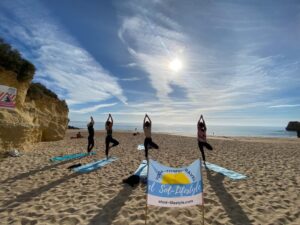If you’re a yoga enthusiast, you may have heard of or even tried practicing yoga on the beach. But have you ever wondered why sand yoga is so popular and how it can actu-ally enhance your yoga practice? In this blog post, we’ll delve into the science behind sand yoga and explore how it can benefit your mind, body, and soul.

1. Building Strength: Sand as a Natural Resistance
One of the unique aspects of practicing yoga on sand is that it provides natural re-sistance. The unstable and shifting surface of sand requires more effort from your muscles to maintain balance and stability. As a result, your muscles work harder to en-gage and stabilize your body in each pose, leading to increased strength and endur-ance. Sand yoga can particularly target the muscles in your feet, ankles, legs, and core, helping to build strength and stability in these areas.
2. Engaging Stabilizer Muscles: A Challenge for Your Core
The uneven surface of sand also engages your stabilizer muscles, which are responsi-ble for maintaining balance and stability. These muscles, often overlooked in tradition-al yoga practices on solid surfaces, are essential for maintaining good posture and pre-venting injuries. Sand yoga forces you to activate these stabilizer muscles more inten-sively, helping to improve your overall balance and stability.
3. Cushioning Impact: Protecting Your Joints
Sand provides a soft and forgiving surface that cushions the impact of your move-ments, making it gentler on your joints compared to hard surfaces like wood or con-crete. This can be especially beneficial for those with joint issues or injuries, as it reduc-es the risk of strain or impact-related injuries during your yoga practice. Sand yoga can provide a safe and supportive environment for your joints, allowing you to enjoy your practice with reduced risk of discomfort or injury.

4. Enhancing Proprioception: Heightening Your Body Awareness
Proprioception is the ability to sense the position and movement of your body in space. Sand yoga challenges your proprioceptive abilities, as the shifting and unstable surface of sand requires constant adjustments in your body positioning to maintain balance. This heightened body awareness can help you develop better coordination, balance, and control, both on and off the mat.
5. Connecting with Nature: Mindful and Grounding Practice
Practicing yoga on the beach allows you to connect with nature in a unique and pro-found way. The calming sound of the ocean waves, the gentle breeze, and the sensa-tion of sand beneath your feet can create a deeply grounding and mindful practice. It can help you relax, reduce stress, and cultivate a sense of peace and tranquility, en-hancing the mental and emotional benefits of your yoga practice.
6. Boosting Mental Clarity: Fresh Air and Vitamin D
The beach environment also offers the benefit of fresh air and natural sunlight, which can help improve your mental clarity and overall well-being. Sunlight exposure can in-crease the production of Vitamin D in your body, which is essential for bone health and immune function. The combination of fresh air, natural sunlight, and the serenity of the beach can enhance your mood, reduce stress, and leave you feeling rejuvenated after your sand yoga practice.
In conclusion, sand yoga offers a unique and beneficial experience for your yoga prac-tice. The natural resistance, engagement of stabilizer muscles, cushioning impact on joints, heightened body awareness, connection with nature, and mental well-being are some of the science-backed reasons why practicing yoga on the beach can enhance your overall yoga experience. So, next time you head to the beach, why not unroll your yoga mat and enjoy the physical, mental, and emotional benefits of sand yoga? Na-maste!



